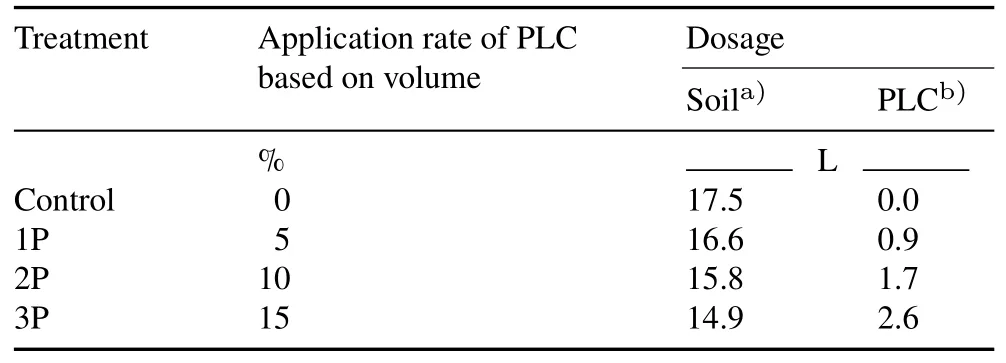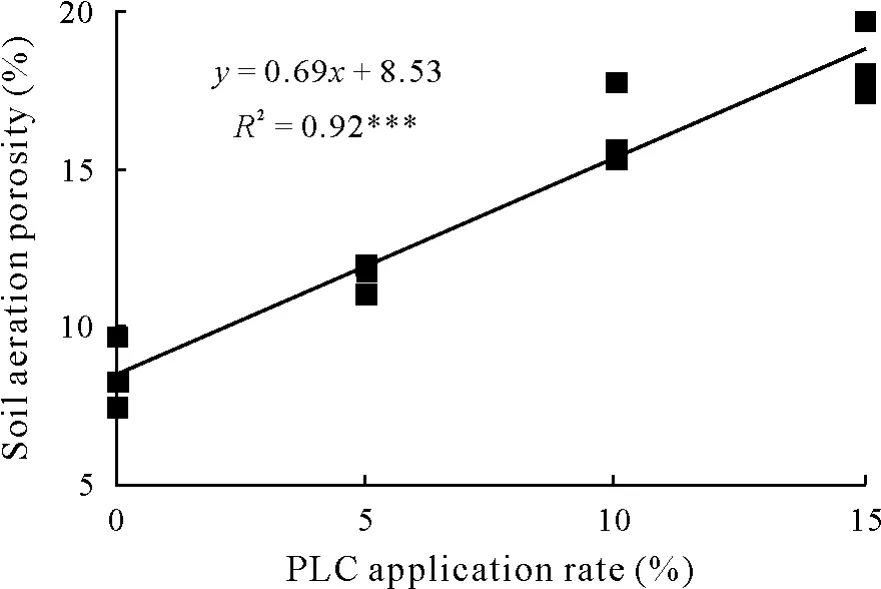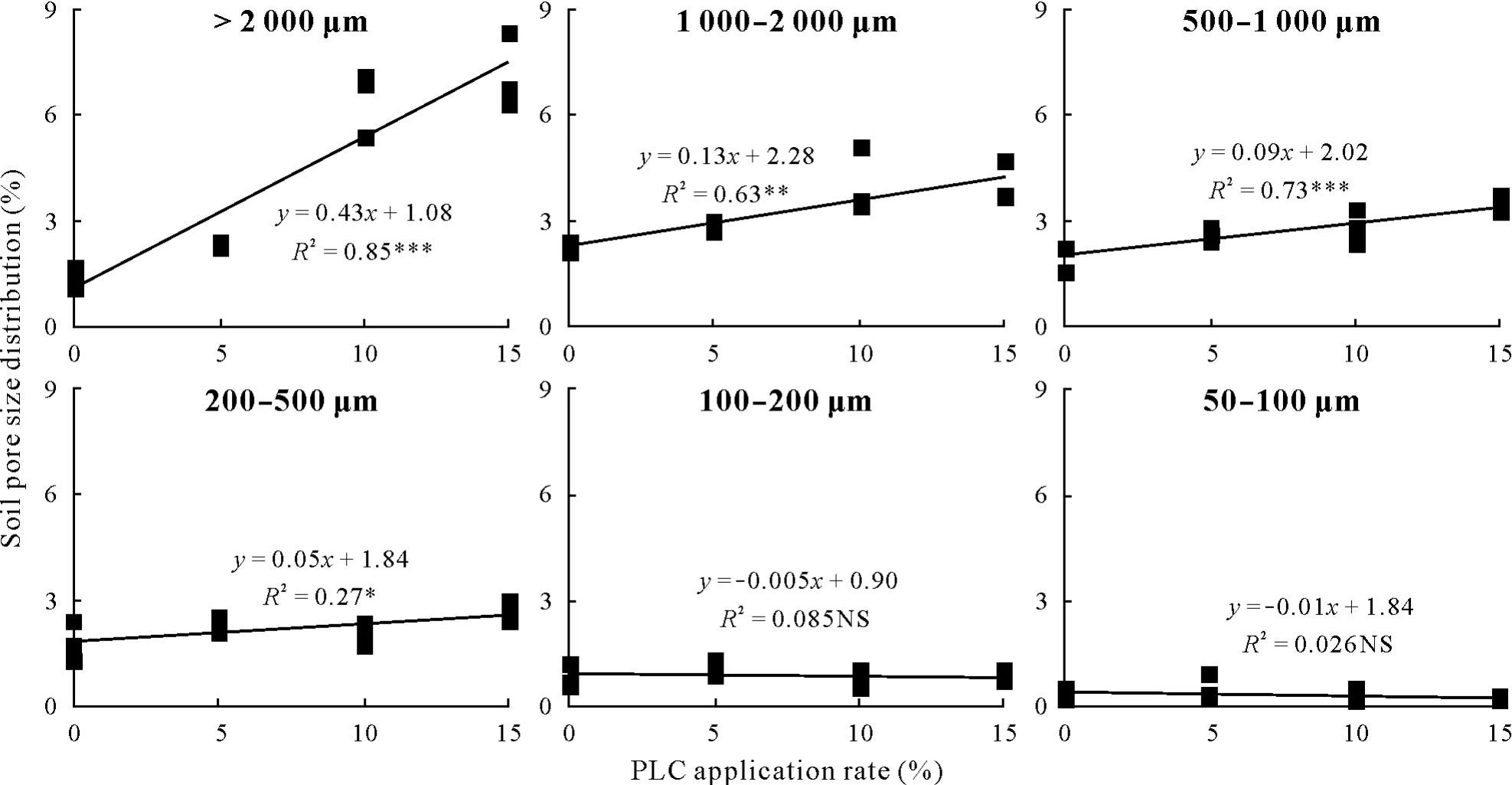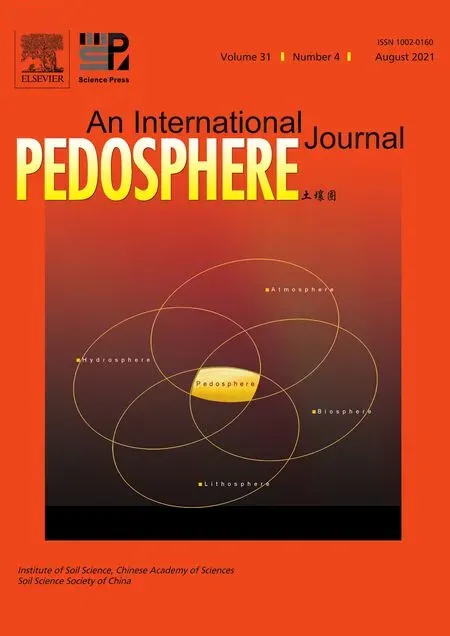Effects of porous clay ceramic rates on aeration porosity characteristics in a structurally degraded soil under greenhouse vegetable production
2021-10-15QuanboYUMeiyanWANGYutianTIANXuezhengSHIXiangweiLILingyingXUXinqiaoXIEYijieSHIandYuncongZHUStateKeyLaboratoryofSoilandSustainableAgricultureInstituteofSoilScienceChineseAcademyofSciencesNanjing0008China
Quanbo YUMeiyan WANG*Yutian TIANXuezheng SHIXiangwei LILingying XUXinqiao XIEYijie SHI and Yuncong ZHUState Key Laboratory of Soil and Sustainable AgricultureInstitute of Soil ScienceChinese Academy of SciencesNanjing 0008(China)
2University of Chinese Academy of Sciences,Beijing 100049(China)
3Hongta Tobacco Group Company Limited,Yunnan 653100(China)
ABSTRACTSoil structure degradation in greenhouse vegetable fields reduces vegetable production.Increasing aeration porosity is the key to ameliorating soil structure degradation.Thus,we tested the effect of a porous material,porous clay ceramic(PLC),on the amelioration of soil structure degradation under greenhouse vegetable production.A 6-month pot experiment was conducted with four PLC application levels based on volume,i.e.,0%(control),5%(1P),10%(2P),and 15%(3P)using Brassica chinensis as the test plant.At the end of the experiment,soil columns were sampled,and the aeration pore network was reconstructed using X-ray computed tomography(CT).The degree of anisotropy(DA),fractal dimension(FD),connectivity,aeration porosity,pores distribution,and shape of soil aeration pores and plant biomass were determined.The DA,FD,and connectivity did not significantly differ as the PLC application rate increased.Nonetheless,aeration porosity significantly linearly increased.The efficiency of PLC at enhancing soil aeration porosity was 0.18%per Mg ha-1.The increase in aeration porosity was mainly due to the increase in pores>2 000 μm,which was characterized by irregular pores.Changes in aeration porosity enhanced the production of B.chinensis.The efficiency of PLC at increasing the plant fresh weight was 0.60%,3.06%,and 2.12%per 1%application rate of PLC for the 1P,2P,and 3P treatments,respectively.These results indicated that PLC is a highly efficient soil amendment that improves soil structure degradation by improving soil aeration under greenhouse conditions.Based on vegetable biomass,a 10%application rate of PLC was recommended.
Key Words:aeration pore network,mineral amendment,pore size distribution,soil physical property,soil structure degradation
INTRODUCTION
The increase in vegetable consumption and the economic benefits of vegetable production have promoted rapid development in greenhouse vegetable production(GVP)(Liet al.,2015;Huet al.,2017).However,many ecological and soil problems,such as nutrient accumulation,acidification and salinity of soils,and groundwater contamination,can occur under GVP(Shiet al.,2009).These problems are caused by intensive agricultural management and environmental conditions,such as high rate of fertilization,cropping index,and temperature,associated with GVP(Huet al.,2017).Soil structure degradation also occurs under greenhouse conditions(Wolfeet al.,1995;Woet al.,2009).It is characterized by an increase in soil bulk density and decreases in soil aggregate stability and number of soil pores,especially macropores(Hornet al.,1995;Bronick and Lal,2005;Kimet al.,2010).
Soil porosity,especially macroporosity,is the best indicator of soil structure quality(Pagliai and Vignozzi,2002).Aeration pores(macropores)are the key influencers of soil functions,such as soil aeration(Startsev and McNabb,2009),permeability(Kuncoroet al.,2014),and mechanical resistance(Smithet al.,1997).Therefore,a decrease in aeration porosity deteriorates soil function,limiting rooting depth and reducing crop yields(Munkholmet al.,2005).
Traditionally,organic and mineral amendments have been frequently used to increase the number of soil aeration pores.The application of organic amendments such as sewage sludge,crop residues,compost,and poultry manure can increase soil organic matter(OM)content(Bazzoffiet al.,1998;Celiket al.,2010;Pengthamkeeratiet al.,2011).Many soil physical properties and functions,such as aggregation,total porosity,resistance to water and wind erosion,hydraulic conductivity,water-holding capacity,bulk density,penetration resistance,and the degree of compaction,are improved due to the enhancement of OM(Celiket al.,2010).Soil porosity,especially aeration porosity,is also improved by adding organic amendments.For instance,Rasoolet al.(2008)investigated the effect of long-term application of farm yard manure(FYM)on soil porosity and showed that soil porosity under FYM increased to 43%compared with the control treatment(37%).Yazdanpanahet al.(2016)examined the effect of application of urban municipal solid waste compost and alfalfa residue on the number of soil aeration pores and found that aeration porosity increased from 12%to 28%with increasing application of organic amendments.Xuet al.(2018)also studied the effect of long-term application of OM and found that aeration porosity increased from 4.79% to 16.36% after 14 years of OM application.Therefore,extensive and long-term application of organic amendments significantly increases the number of aeration pores.Despite the positive effects of OM application,there are also some challenges.First,the organic amendments need to be applied extensively and for a long period(Huet al.,2017;Xuet al.,2018),increasing the cost to farmers.Second,the OM applied to greenhouse soil may last for a shorter period of time than OM applied to cropland under natural conditions.This is because OM decomposition may be accelerated under greenhouse vegetable fields due to high temperature and humidity and intensive cultivation(Sixet al.,2000;Curtinet al.,2012).Third,soils with applied organic amendments are vulnerable to soil compaction,and thus structural stabilization may take a long time(approximately one year)(Balesdentet al.,2000;Kaufmannet al.,2009;Grosbelletet al.,2011).Therefore,the effect of OM on aeration pores under greenhouse conditions may be limited.
Compared with organic amendments,mineral amendments are stable and difficult to decompose.Many mineral amendments,such as vermiculite,calcined clay,shell sand,and sand,have been used to improve soil structure(Morganet al.,1966;Taylor and Blake,1979;Sognneset al.,2006).Among these amendments,sand is the most common mineral additive(Taylor and Blake,1979,1984).Adding sand to the soil can increase hydraulic conductivity(Gillet al.,2004;Chi and Wang,2009),stimulate carbon mineralization(Marhan and Scheu,2005),and resist compaction(Taylor and Blake,1979).However,the efficiency of sand for increasing the number of soil aeration pores may be limited due to its high density.Since soil structure degradation is characterized by decreased aeration porosity,directly increasing the number of pores may ameliorate soil structure degradation(Hamza and Anderson,2005;Colombiet al.,2017).To this end,we attempted to use a mineral material that is rich in aeration pores to improve soil structure under greenhouse conditions.
Porous clay ceramic(PLC)is a mineral material with low density and high aeration porosity.Little information is available on the effect of PLC on soil structure degradation under greenhouse vegetable cultivation.Thus,our objectives were to i)quantitatively analyze the impacts of PLC on aeration porosity characteristics in a structurally degraded soil under greenhouse conditions using X-ray computed tomography(CT)and ii)determine the most efficient application rate of PLC to enhance greenhouse vegetable production.
MATERIALS AND METHODS
Soil and PLC
The soil was collected from the top 15 cm of a greenhouse vegetable field that had been cultivated for 7 years in the suburban area of Nanjing,eastern China.The soil was silty clay loam,with a bulk density of 1.30 Mg m-3and a pH of 4.25.The OM and total nitrogen(TN)contents of the soil were 22.9 and 1.80 g kg-1,respectively.
The PLC is an inorganic amendment that is calcined under high temperature.In this study,PLC with 2–7 mm particle sizes(pH=8.64,loose bulk density=0.2 Mg m-3)was used to improve soil structure under greenhouse conditions.
Pot experiment
A pot experiment was established in a greenhouse located at the Institute of Soil Science,Chinese Academy of Sciences on November 24,2016.The soil used for the pot experiment was air-dried and then sieved through a 5-mm sieve after gravel and residues were removed.The treated soil was homogenized and thoroughly hand mixed with different volumes of PLC(Table I)before packing in polypropylene pots(35.5 cm×26.5 cm×21 cm).The application rates(volume basis)of PLC for the control(CK),1P,2P,and 3P treatments were 0%,5%,10%,and 15%,respectively.For the CK,1P,2P,and 3P treatments,the dosages of PLC were 0.0,0.9,1.7,and 2.6 L,respectively,while the dosages of soil were 17.5,16.6,15.8,and 14.9 L,respectively.Each treatment had three replicates.Twelve pots were arranged in a randomized block design.

TABLE IApplication rates of porous clay ceramic(PLC)and the dosages of soil and PLC for the different treatments in the pot experiment
The pots were equilibrated by saturating the soil with water for one week.The top 5 cm of each pot was tilled after application of compound fertilizer at 750 kg ha-1.Ninety seeds ofBrassica chinensiswere planted in each pot.Seedlings in each pot were thinned to four individuals for biomass determination 24 d after sprouting.During the growth period ofB.chinensis,525 kg ha-1additional fertilizer was applied.Each pot was watered with the same amount of water every time when the surface of soil in the pot became dry.
After six months,B.chinensisshoots from two plants in each pot were harvested.The harvested plants were washed clean with deionized water and dried by using a gauze.The fresh and dry weights of fourB.chinensisshoots from each pot were determined according to the method described by Heet al.(2016).
Soil column collection,preparation and X-ray CT scanning
After plant harvest,one undisturbed soil column,50 mm in diameter and 80 mm in length,was collected from the top 0–10 cm in each pot using a polyvinyl chloride pipe.All columns were wrapped by a preservative film separately to prevent soil moisture loss and stored at 4°C before scanning.Soil columns were scanned within one week after sampling(Quinet al.,2014)using an industrial Nanotom CT scanner(Nanotom S,Phoenix,USA)at 100 kV and 100 μA,producing 2 301×2 301 images with voxel size of 25 μm×25 μm×25 μm.A total of 255 32-bit TIFF(tagged image file format)greyscale images were used to store the voxel-associated attenuation coefficients,and saved as 8-bit TIFF images by using VG Studio MAX 2.2 software(Volume Graphics,Germany).
Image processing and analysis
Digital image processing and analysis were performed using the public domain image processing software ImageJ(Abràmoffet al.,2004).A 1 600-slice section of each image stack was used for analysis.To avoid edge effects,each slice was clipped to a centrally located area of interest(30 mm×30 mm×40 mm).A filter median was used to reduce image noise before image segmentation.A clustering-based thresholding method was used for image segmentation(Gł˛ab,2007),along with manual thresholding(Fig.1)(Quinet al.,2014).

Fig.1 Segmentation of the X-ray computed tomography images from the different treatments with porous clay ceramic application rates of 0%(control,CK),5%(1P),10%(2P),and 15%(3P)based on volume.The porous material in the ovals is porous clay ceramic.
When image processing was performed,some characteristics of soil aeration pores(pore size greater than 50 μm),such as pore size,shape,and morphological indicators(connectivity,degree of anisotropy(DA),and fractal dimension(FD)),were quantified.Pore size and shape were estimated by pore area statistics in the area of interest of each slice from each binarized stack(Udawattaet al.,2006).The pore sizes were divided into six classes according to Gł˛ab(2007):50–100,100–200,200–500,500–1 000,1 000–2 000,and>2 000 μm.Each of the six classes was divided into three fractions according to their shape(Pagliaiet al.,1983),as expressed by circularity(4π·area/perimeter2):elongated(0–0.2),irregular(0.2–0.5),or regular(0.5–1).
The morphological indicators were calculated according to Dal Ferroet al.(2013),Pajoret al.(2010),and Munkholmet al.(2012).The DA was calculated according to the mean intercept length(MIL)method(Harrigan and Mann,1984).Briefly,vectors from a random point within the sample were built,which were in all directions with the same length.Then,the MILs of the random point in all directions were calculated by dividing the length of vectors by the number of boundary hits between the foreground(pores)and background(soil matrix).Further,a material anisotropy tensor was established by fitting the MILs with an ellipsoid.Finally,the smallest and largest eigenvalues of material anisotropy tensor were determined and DA was calculated as:

whereEsandElare the smallest and largest eigenvalues,respectively.The DA ranged from 0(isotropic structure)to 1(anisotropic structure).
The FD was calculated according to the box-counting algorithm(Fazzalari and Parkinson,1996).A series of boxes of diminishing size(ε)were scanned over the image and the number of boxes(N(ε))of each size containing foreground(pores)was counted.As the box size decreased,the proportion of boxes containing foreground increased in a fractal structure.TheN(ε)values varied withεaccording to the following equation:

The FD was estimated from the slope of log(1/ε)against log(N(ε)).The connectivity of soil aeration pores was determined by the Euler characteristic(Odgaard and Gundersen,1993;Toriwaki and Yonekura,2002).To ensure that there is only one particle in the foreground,“Purify”was run prior to“Connectivity”.The Euler characteristic of the volume was calculated by voxel neighbourhoods and adjusted to determine the contribution of the volume to the connectivity of soil aeration pores it was cut from.
Statistical analysis
Data were analyzed using SPSS version 19.0 for Windows(SPSS Inc.,USA).Analysis of variance(ANOVA)was used to examine the effects of PLC on the aeration porosity,pore size distribution,shape,DA,FD,and connectivity of soil aeration pores and fresh and dry weights and water content ofB.chinensis.Means were compared using the least significant difference(LSD)test.Differences were considered significant atP<0.05.Correlation analysis was employed to examine the correlations among soil aeration porosity,pore size distribution,and PLC application rate.
RESULTS
Change in soil aeration pore morphology
As shown in Table II,as the PLC application rate increased,DA first decreased from 0.33(CK)to 0.23(2P)and then increased to 0.32(3P);FD increased slightly from 2.72(CK)to 2.80(3P);and connectivity increased from 152 039(CK)to 453 204(2P)and then decreased to 200 279(3P).The change in soil aeration pore morphology indicated that PLC could increase soil aeration.However,these three pore morphology parameters did not show significant differences among treatments.

TABLE IIMorphology indicators,degree of anisotropy(DA),fractal dimension(FD),and connectivity,of the soil aeration pore network in the different treatments with porous clay ceramic application rates of 0%(control,CK),5%(1P),10%(2P),and 15%(3P)based on volume
Enhancement of soil aeration porosity
The aeration porosity increased significantly with increasing application rates of PLC(Fig.2).Under the CK treatment,the aeration porosity was 8.50%on average,ranging from 7.47%to 9.72%.The aeration porosity increased significantly to 11.60%on average under the 1P treatment and 16.25%under the 2P treatment.When the PLC application rate was 15%(3P),the aeration porosity increased to 18.41%on average,ranging from 17.42%to 19.75%.

Fig.2 Relationship between soil aeration porosity and porous clay ceramic(PLC)application rates(0%,5%,10%,and 15%based on volume).The asterisks***indicate significant difference at P<0.001.
The slope of the fitted line was 0.69,which means that the efficiency of PLC for increasing the aeration porosity was 0.69%per 1%application rate of PLC,i.e.,0.18%per Mg ha-1.In this study,the coefficient of determination of the fitted line was 0.92,indicating that PLC application could explain 92%of the increase in aeration porosity.

The number of soil aeration pores>200 μm significantly increased,while the number of pores of 50–200 μm did not differ as the PLC application rate increased(Fig.3).Under the CK treatment,the sizes of soil aeration pores were mainly 200–500,500–1 000,and 1 000–2 000 μm,accounting for 20.92%,23.31%,and 26.59%of the total aeration porosity,respectively.However,the proportion of soil aeration pores of 50–500 μm slightly decreased,while the proportion of those of 500–2 000 μm increased by 3.58%when the application rate increased to 5%.When the application rate was 10%,the pore size was mainly>2 000 μm,which accounted for 39.71%of the total aeration porosity,and the pore size of 1 000–2 000 μm accounted for 24.52%.The distribution of pore sizes under the 15% application rate was similar to that under the 10%application rate.The changes in the pore size distribution indicated that PLC application significantly changed the pore size distribution of soil aeration pores,a higher proportion of larger pores(>2 000 μm)observed under higher application rate of PLC.

Fig.3 Porosity of different soil pore size classes and shapes in the four treatments with porous clay ceramic application rates of 0%(control,CK),5%(1P),10%(2P),and 15%(3P)based on volume.The numbers 1,2,3,4,5,and 6 in the x-axis represent pore size classes 50–100,100–200,200–500,500–1 000,1 000–2 000,and>2 000 μm,respectively.
Porosity of the>200 μm soil pore class in the four treatments increased linearly with increasing PLC application rate(Fig.4).The efficiency of PLC at increasing the porosity was the highest in the>2 000 μm class,followed by the 1 000–2 000,500–1 000,and 200–500 μm classes,with efficiency of 0.43%,0.13%,0.09%,and 0.05% per 1%application rate of PLC,respectively.Differences in the impacts of PLC on the pore size distribution may be mainly attributed to the pore structure of PLC and its interaction with the surrounding soil particles.

Fig.4 Relationships between soil pore size distribution and porous clay ceramic(PLC)application rates(0%,5%,10%,and 15%based on volume).The asterisks*,**,and***indicate significant differences at P<0.05,P<0.01,and P<0.001,respectively.NS=not significant.
The PLC application significantly changed the shape of the pores in the>200 μm class,while no differences were found for the pores in the 50–200 μm class.In the 200–2 000 μm class,the number of regular and irregular pores significantly increased when the application rate increased up to 15%,while in the>2 000 μm class,elongated and irregular pores significantly increased when the application rate increased up to 10%.This indicates that PLC had a greater influence on the elongated pores compared to regular and irregular pores.
Effect of PLC application rate on B.chinensis biomass
Application of PLC significantly increased the fresh weight ofB.chinensis(Table III).When the PLC application rate increased from 0%to 5%,the fresh weight ofB.chinensisincreased by only 3.00%.Then,the fresh weight ofB.chinensisincreased dramatically by 30.68% and 31.77%when the PLC application rate increased to 10%and 15%,respectively.Substantial differences were also observed in the efficiency of PLC at increasing the fresh weight ofB.chinensisunder different application rates.The greatest increase in the fresh weight ofB.chinensiswas under the 10% application rate of PLC(the increase was observed at 3.06%per 1%application rate),followed by under 15%(2.12%),and the lowest was under 5%(0.60%).

TABLE IIIFresh and dry weights and water mass of Brassica chinensis in the different treatments with porous clay ceramic application rates of 0%(control,CK),5%(1P),10%(2P),and 15%(3P)based on volume
The dry weight ofB.chinensisunder the amended treatments did not significantly differ from that under the unamended treatment(Table III).It was the highest in the 2P treatment,followed by that in the 3P treatment,and the lowest in the 1P treatment.Water uptake byB.chinensissignificantly varied among treatments.The water content ofB.chinensisincreased with increasing PLC application rate,with the highest content in the 2P and 3P treatments and the lowest content in the CK and 1P treatments.The results indicated that PLC increased the uptake of water byB.chinensisplants.
DISCUSSION
Efficiency of PLC at enhancing soil aeration porosity
In this study,the efficiency of PLC at increasing soil aeration porosity was 0.18%per Mg ha-1.Addition of OM is frequently performed to improve soil aeration porosity(Motavalliet al.,2003;Tan and Chang,2007).However,the efficiency of OM at increasing soil aeration porosity varies substantially.Sort and Alcañiz(1999)reported that soil aeration porosity increased from 11.0%to 29.1%after sewage sludge was applied to plots at an application rate of 400 Mg ha-1for 1 year to rehabilitate deeply eroded soil located in the talus of a limestone quarry.Dal Ferroet al.(2013)found that soil total porosity(>80 μm)increased by 3%under liquid manure application at a rate of 120 Mg ha-1.Głab and Gondek(2008)reported that soil aeration porosity decreased after the application of four organic amendments to Stagnic Gleysol at a low application rate(<15 Mg ha-1).However,soil aeration porosity could also be improved with long-term application of organic amendments at a low application rate.Xinet al.(2016)showed that a low application rate(4.5 Mg ha-1)of organic amendment increased soil aeration porosity(>40 μm)by 10.2%after 23 years.Thus,in the present study,the efficiency of PLC at increasing soil aeration porosity was greater compared with those of most organic amendments in the short term.
Potential of combined use of PLC and organic amendment
The mechanisms by which PLC increased soil aeration porosity were due to two factors.First,PLC can directly increase soil aeration porosity due to its porous structure(Fig.1).The total porosity of this material can be up to 90.0%,with aeration porosity of 70.0%.Thus,the highly porous structure of PLC applied to soil improves soil physical properties,such as total porosity,pore size distribution(Hardieet al.,2014),and pore shape(Table III).Second,packing or accommodation pores are created between PLC and the surrounding soil aggregates.However,the mechanism for PLC improving aeration porosity is different from that for OM.Addition of OM increases soil OM(Liet al.,2018;Maltaset al.,2018),which can act as a binding agent that binds microaggregates together into macroaggregates(Elliott,1986).This causes rearrangement of the soil structure and increases the porosity of the macroaggregates(Yuet al.,2016).
Despite the different mechanisms of PLC and organic amendments,the combined use of PLC and organic amendments may be a better choice for long-term GVP than the use of either of the materials alone.First,the combined use of these materials can quickly enhance soil aeration,and OM is very important for maintaining agricultural productivity and environmental quality(Reeves,1997).However,soils amended with OM need a long time to stabilize,and during this process,they are still sensitive to compaction(Balesdentet al.,2000;Kaufmannet al.,2009;Grosbelletet al.,2011).In contrast,PLC could quickly enhance soil aeration porosity,such as from 8.50%(CK)to 18.41%(3P)within 6 months as observed in this study.Second,the duration of soil aeration may increase with combined application of OM and PLC.The stability of PLC is greater than that of OM due to the high-temperature production process of PLC.Improvement of soil structure by organic amendments may be short lived due to the high cultivation intensity and temperature in greenhouse vegetable fields(Sixet al.,2000;Huet al.,2017).Third,the effects of porosity on plant growth may be improved by PLC.The number of pores>2 000 μm decreased with long-term application of organic amendments in a greenhouse vegetable field(Xuet al.,2018);however,PLC has a high efficiency at enhancing larger pores,especially pores>2 000 μm(Fig.3).Thus,the combined use of PLC and organic amendments may be a better choice than the used of either material alone for improving soil structure under greenhouse conditions.
Soil aeration porosity threshold and PLC rate recommdation for greenhouse vegetable production
Our result showed that PLC increased the number of pores>500 and 200–500 μm.This is in contrast to the results of Dal Ferroet al.(2013)and Pagliaiet al.(2004),who reported that the number of larger pores(>560 and>500 μm,respectively)increased while the number of smaller pores decreased with the addition of organic material.Additionally,in our study,the pore sizes were mainly distributed in the>1 000 μm size classes,especially in the>2 000 μm size class,in line with the results of Pagliaiet al.(2004)but different from those of Dal Ferroet al.(2013).These contrasting results are because PLC increased soil aeration porosity directly rather than reallocating it by shifting the pores from small to large pore sizes(Dal Ferroet al.,2013).
Large pores(>400 or>500 μm)cannot retain much water(VandenBygaartet al.,1999;Dal Ferroet al.,2013).However,in our study an increase in the>500 μm pore sizes still promoted nutrient and water utilization byB.chinensis(Table III).This result may be due to the lack of a significant change in the connectivity of soil aeration pores and the significant change in pore size due to a change in the pore size distribution(Udawattaet al.,2006).Both the aeration porosity and pore shape are important for the utilization of water by vegetables in structurally degraded soils(Udawattaet al.,2006;Yanget al.,2018).
Traditionally,soil aeration porosity of 10% is often considered a crucial threshold for plant growth under natural conditions(Baver and Farnsworth,1941;Zouet al.,2001).However,this value may be too low for the greenhouse vegetable production due to high temperature(Saif,1981;Palta and Nobel,1989;Huanget al.,1998).Our results also showed that when soil aeration porosity increased to 11.60%,the biomass ofB.chinensisincreased by only 3.00%.Moreover,when soil aeration porosity increased to 16.25%with a 10%PLC application rate,the biomass ofB.chinensisincreased by 30.68%.A range of 12%–15%may be a more appropriate aeration porosity limit for plant growth under greenhouse conditions(Grable and Siemer,1968).When the application rate of PLC increased to 15%,the efficiency of PLC at enhancing the production ofB.chinensisdecreased despite the higher soil aeration porosity.Thus,both soil aeration porosity and the efficiency of PLC at increasing vegetable biomass should be considered when applying PLC.In our study,a PLC application rate of 10%was appropriate for structurally degraded soils under greenhouse vegetable production.
CONCLUSIONS
Soil structure degradation in greenhouse vegetable fields affects vegetable production.In this study,a porous mineral material,PLC,was used to ameliorate this problem.Xray CT was used to quantify the network of soil aeration pores.The results showed that PLC can enhance soil aeration porosity and efficiently change the distribution and shapes of pores,despite the lack of a significant change in the complexity of the pore system.The incorporation of PLC also efficiently enhanced the biomass ofB.chinensis.Thus,soil amendment of PLC was highly efficient at improving soil aeration porosity under greenhouse condition,and a PLC application rate of 10%was recommended.
ACKNOWLEDGEMENT
This study was supported by the National Natural Science Foundation of China(Nos.41571209 and 41401240),the 135 Plan and Frontier Fields Program of the Institute of Soil Science,Chinese Academy of Sciences(No.ISSASIP1627),and the Technology Project of Hongta Tobacco Group Company Limited,China(No.HT2016-6221).
杂志排行
Pedosphere的其它文章
- News First Hot Paper among the papers published in Pedosphere
- Stabilization of chromium(VI)by hydroxysulfate green rust in chromium(VI)-contaminated soils
- Soil property mapping by combining spatial distance information into the Soil Land Inference Model(SoLIM)
- Toxicity of lead pollution to the collembolan Folsomia candida in Ferri-Udic Cambosols
- Proximal sensor-enhanced soil mapping in complex soil-landscape areas of Brazil
- Adsorption of emerging sodium p-perfluorous nonenoxybenzene sulfonate(OBS)onto soils:Kinetics,isotherms and mechanisms
